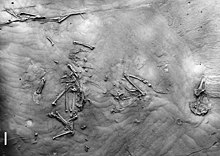Wieslochia weissi is an extinct species of passerine bird from the early Oligocene (27.8–33.9 Ma) of Germany.[1] Remains of this species have been found in a clay pit in Frauenweiler near Wiesloch, Germany. The holotype is a dissociated skeleton on two slabs. Another specimen consisting of a mandible and a cranium has been found in the same geological area. The taxonomic affinities of Wieslochia are not well understood as it shares some similarities with suboscines but it seems more primitive in other features. It was first described by Gerald Mayr and Albrecht Manegold.[1] A 2024 study found strong support for it and the related Crosnoornis being members of the Tyranni, either as stem group or crown group members of the Eurylaimides.[2]
| Wieslochia Temporal range:
| |
|---|---|

| |
| Scientific classification | |
| Domain: | Eukaryota |
| Kingdom: | Animalia |
| Phylum: | Chordata |
| Class: | Aves |
| Order: | Passeriformes |
| Suborder: | Tyranni |
| Genus: | †Wieslochia G. Mayr & A. Manegold, 2006 |
| Species: | †W. weissi
|
| Binomial name | |
| †Wieslochia weissi G. Mayr & A. Manegold, 2006
| |
References
edit- ^ a b Mayr, Gerald; Manegold, Albrecht (2006). "New specimens of the earliest European passeriform bird". Acta Palaeontologica Polonica. 51 (2): 315–323.
- ^ Lowi-Merri, Talia M.; Gjevori, Martina; Bochenski, Zbigniew M.; Wertz, Krzysztof; Claramunt, Santiago (2024-12-31). "Total-evidence dating and the phylogenetic affinities of early fossil passerines". Journal of Systematic Palaeontology. 22 (1). doi:10.1080/14772019.2024.2356086. ISSN 1477-2019.